- Category:
- Tag:
What is ACF (Anisotropic Conductive Film)?Its usages, how to apply, types, and more are explained.

What is ACF (Anisotropic Conductive Film)?
ACF is the initialism for “Anisotropic Conductive Film” or “Anisotropic Conductive Adhesive Film.” It is made of resins, such as thermoset epoxy resin, in which conductive particles are dispersed. ACF fixed by thermocompression bonding can achieve conductivity vertically, or in the direction of compression, and insulation quality horizontally, or in the perpendicular direction to compression, and because of its anisotropic nature, the material is referred to as “Anisotropic Conductive Film.”
ACF is found in almost all devices with a flat panel display, including smartphones, tablets, PCs, and televisions. The film is used to electrically connect the electrodes of the glass substrates of LCDs or OLED displays and the electrodes of IC chips or flexible substrate circuits, and also physically fixes them.
ACF is about 10-45μm thick and 0.4-20mm wide. To connect the electrodes of the devices described above, ACF is placed between the electrodes and thermocompression is applied. Through this process, conductive particles are compressed, touch one another, and form a conductive path between the upper and lower electrodes. Meanwhile, some particles remain uncompressed and dispersed in the resin, maintaining the electrodes’ insulation quality in a horizontal direction. As the resin hardens in this state, the electrodes also become physically joined, fixed, and sealed.
Compared with bonding by solder or connector parts, the use of ACF in connecting electrodes (hereinafter, “ACF connection”) can make the combined area smaller, thinner, flatter, and the pitches narrower. Other notable merits include the simultaneous connection of multiple electrodes. ACF also works at low temperatures between roughly 100 and 240 degrees Celsius and in a short time of 4 to 60 seconds.
What is ACF?
ACF’s structure before use
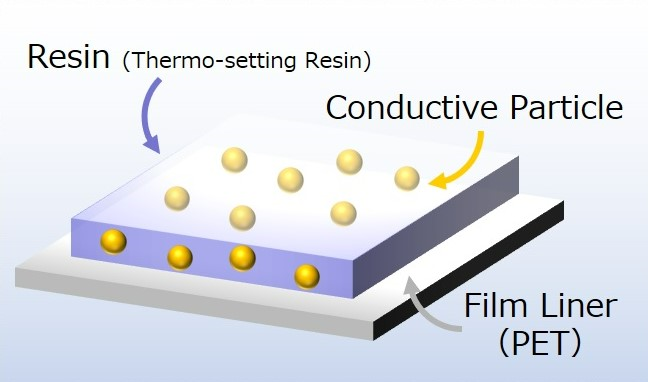
ACF’s anisotropic properties after thermocompression

ACF interconnection by the thermocompression process
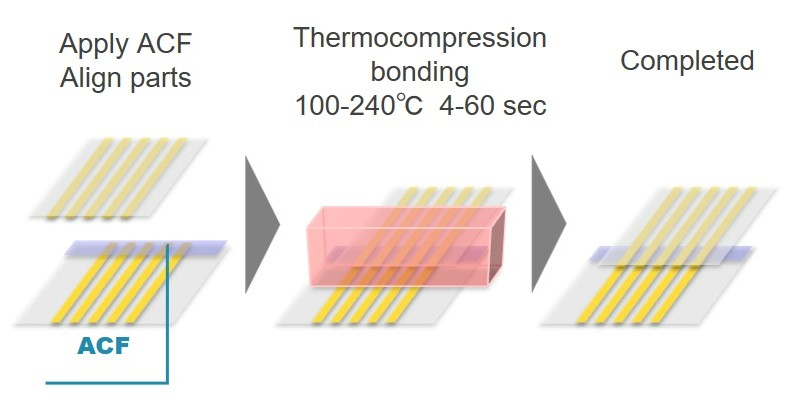
Merits of ACF connection

Usages of ACF
ACF used in LCDs and OLED displays
In the flat panel displays of smartphones, tablets, PCs, and televisions, transparent electrodes are patterned on the glass substrate to activate the individual cells of liquid crystals or OLEDs. The transparent electrodes and driver ICs that activate these cells must be electrically connected; however, soldering cannot be used for connection because ITO used as transparent electrodes does not form a eutectic system with solder. Since an equal number of electrodes as the liquid crystal cells must be aligned within the display size, another problem is the limitation on the maximum space between the electrodes, or the connection pitch, to avoid short-circuiting the adjacent electrodes. As HD displays become higher in resolution and smaller in size, the connection pitch has to be narrower.
In 1984, Hitachi Chemical (the predecessor of RESONAC), became the world’s first manufacturer to put ACF connection to practical use in compact LCD TVs. Films using carbon fibers as conductive particles were known earlier, but the connection pitch could be narrowed only up to 500μm1) and fell short of meeting the requirements of LCD TVs at the time. RESONAC succeeded in satisfying the requirements of LCD TVs by adopting metal conductive particles and adjusting the amount and state of the dispersed particles1).
RESONAC continued to improve ACF over the years. By developing conductive particles, resin materials, and dispersing technology further, RESONAC succeeded in reducing the connection pitch to 100μm or smaller in 1992. In 2016, the company unveiled its Particle-Aligned Anisotropic Conductive Film (hereinafter, “PAL-ACF”) 2), which uses the technology of dispersing conductive particles evenly in the film. Today, RESONAC’s ACF “ANOSOLM” has achieved a connection pitch of 20μm with these technologies.
In this way, ACF is increasingly being used in higher definition, smaller LCDs, and OLED displays with enhanced pitch resolution. Since it can make the connection area physically thin, ACF also contributes to producing thinner displays.
Used in displays, ACF can demonstrate its many features, enabling small, thin, flat, and narrow-pitch connections, and handling numerous electrodes at the same time. RESONAC’s ACF “ANISOLM” also achieves the smallest width in the industry at 0.4mm.
- 1) Itsuo Watanabe, ‘Anisotropic Conductive Adhesive Film,’ Journal of the Japan Institute of Electronics Packaging, Vol. 8, No. 4, p. 346, 2005, Material Application Seminar Vol. 2.
https://www.jstage.jst.go.jp/article/jiep1998/8/4/8_4_346/_pdf(written in Japanese)
- 2) Akiko Iwai, Masaru Tanaka, “Particle-Aligned Anisotropic Conductive Film(PAL-ACF)for Fine Pitch Interconnection,” Hitachi Chemical Technical Report, No. 59, p. 11, 2016.
https://www.resonac.com/sites/default/files/2022-12/en_pdf-rd-report-059-59_tr02.pdf
Uses in LCDs and OLED displays
Large displays

Small to medium displays
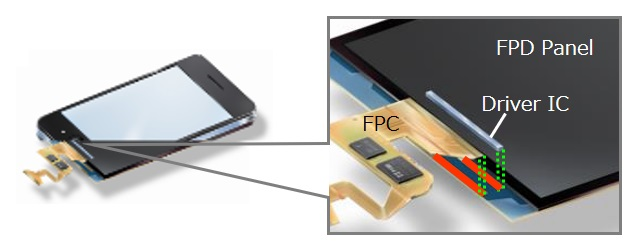
Types of ACF connections used in displays
In one method, transparent electrodes and the electrodes (gold bumps) of driver ICs (chips) are connected directly by placing ACF between the glass substrate’s transparent electrodes and the chips. Another method is to connect the flexible printed circuits (FPCs), with driver ICs mounted on a flexible printed substrate, and the glass substrate’s transparent electrodes.
The latter method is commonly used for large displays, while both methods are employed for small to medium displays. The former method is referred to as COG (Chip on Glass), or described as “mounting IC chips on a glass substrate.” The latter method is also used for slim displays or bezel-less smartphones. ACF connection between transparent electrodes and FPCs is referred to as FOG (Flex on Glass, Film on Glass) or FPC on Glass. COF (Chip on Flex) means ACF connection between FPCs and IC chips. Making COF-type ACF connections can also be explained as “mounting IC chips on FPC.”
The use of ACF is not limited to displays, as ACF connection is also adopted in other types of assemblies, such as FOB (Flex on Board) between FPC and PCB (printed circuit board), FOF (Flex on Flex), which combines FPCs, and FOP (Flex on Plastic), which joins FPCs and plastic substrates such as PET, COP or CPI.
RESONAC’s ACF “ANISOLM” offers various grades to meet these types of connections. Please contact us freely from the “Inquiry” button.
Types of ACF connections

Uses in touch sensors
In smartphones and tablets, touch sensors are built on or in the display. To detect a change in capacitance when the display is touched, transparent electrodes are patterned on a transparent film substrate or a glass substrate. While the electrodes of the peripheral areas and transparent electrodes can be connected with silver paste, etc., ACF can also be used to connect the electrodes and driver ICs for sensing, as in displays.
For out-cell, slim types it is common to use ACF connection (FOP) to join transparent electrodes on a transparent film substrate or electrodes linked by silver paste or copper in the peripheral areas and FPC. As displays, touch sensors can make use of ACF’s features in achieving small, thin, flat, fine-pitch connections and the joining of many electrodes simultaneously.
Uses in touch sensors
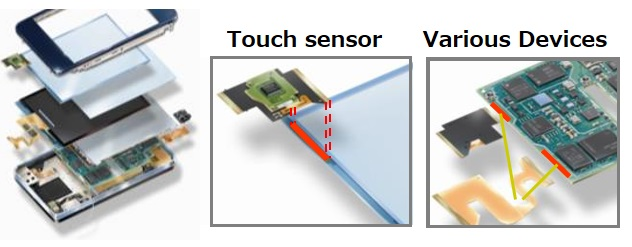
Uses in semiconductor device connection
In addition to displays and touch sensors’ driver ICs, ACF is adopted in various semiconductor devices. For example, since ACF works at low temperatures, it is used in heat-sensitive CMOSs (complementary metal-oxide-semiconductors) or CCDs (charge-coupled devices) in the camera modules of smartphones or digital cameras. The use of ACF connection in building micro-LEDs is also a work in progress, since a large number of chips must be mounted at the same time. ACF, which works at low temperatures, is also being adopted in secondary mounting processes, in which semiconductor packages, electronic parts or FPCs are mounted on printed circuit boards.
Semiconductor devices can likewise exploit ACF’s features, such as low-temperature bonding at around 100 to 240 degrees Celsius and the capacity to connect many electrodes simultaneously.
As a future trend, heterostructure semiconductors or multi-chip modules and modularization are expected to advance. Components like MEMS sensors and biosensors, which are heat-sensitive as CMOSs mentioned above, will be included in various packages, increasing the need for ACFs. ACF connection will also become a major solution in mounting semiconductor devices on flexible film substrates in wearable devices and other such products.
Unlike soldering or connector parts, ACF can reduce electrical and thermal resistance, since the spaces between the electrically connected electrodes can be reduced. This leads to decreased conductor and transmission losses in high-frequency communications, while limiting heat dissipation in thermal management and lowering temperatures at chip junctions.
Uses in connecting semiconductor devices
CMOS

Micro-LED

Secondary semiconductor mounting
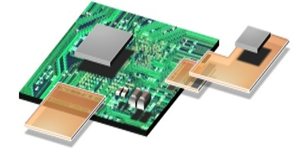
How to use ACF
This section explains how to use ACF, taking as an example the case of mounting IC chips onto a glass substrate (COG) or FPC (COF). This also applies to FOG. First, ACF is attached to the cleaned surface of a substrate. Heat and pressure are then applied without removing the film liner (PET) (Figure 1. Laminate). Next, the film liner is removed (Figure 2) and the IC chip’s electrodes are aligned and accurately positioned for connection (Figure 3). Finally, thermocompression is applied again to fix and connect the parts (Figure 4. Thermocompression).
Before laminating, the surface of the mount board to be connected must be cleaned carefully. Particularly, glass substrates should be cleaned with alcohol, an organic solvent, or by plasma or UV cleaning.
There are two types of thermocompression bonding: the constant heat method and the pulse heat method. In the constant heat method, the bond head is heated continuously to maintain the designated temperature. In the pulse heat method, the bond head is heated only when applied to ACF. When using the latter method, the bond head’s temperature is constantly monitored; if the temperature falls during bonding, it is quickly raised to the designated level. The key points to thermocompression bonding are control of the bond head’s temperature and keeping the bond head and the glass substrate parallel. It is also important to check the state of the conductive particles, resistance value, and adhesive strength after bonding.
The most important point in using ACF is choosing the optimal film. It is crucial to find the right combinations of ACF resin and conductive particles, depending on the substrate materials, the electrode materials and sizes (thickness, width, length), pitch length, and the upper limits of the temperature of both electrodes to be connected. In determining the upper temperature limit, heat resistance of the chips and base materials must be considered.
RESONAC’s ACF “ANISOLM” meets various demands with a wide range of types, as explained in “4. Types of ACF”. Since the adoption of ACF in LCD TVs in 1984, RESONAC has been providing customers with practical ACFs while constantly making improvements. Our knowledge and experience allow us to propose optimal types from RESONAC’s broad ACF lineup to meet the bonding and connection requirements of our customers. We also provide consultation on detailed conditions such as thermocompression temperature and duration. Please contact us freely from the “Inquiry” button.
How to use ACF
Figure 1.
ACF laminate

Figure 2.
Film liner removal
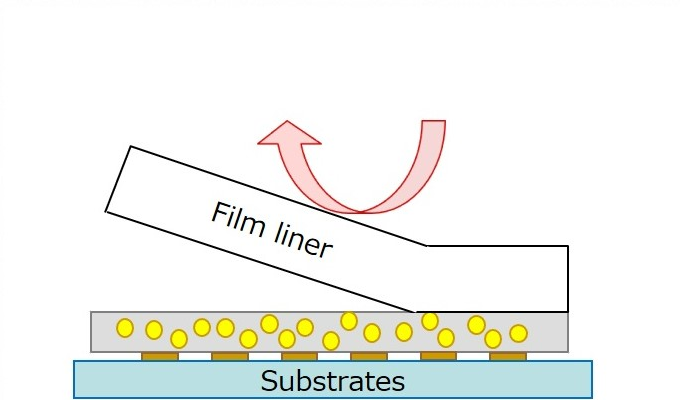
Figure 3.
Electrode alignment
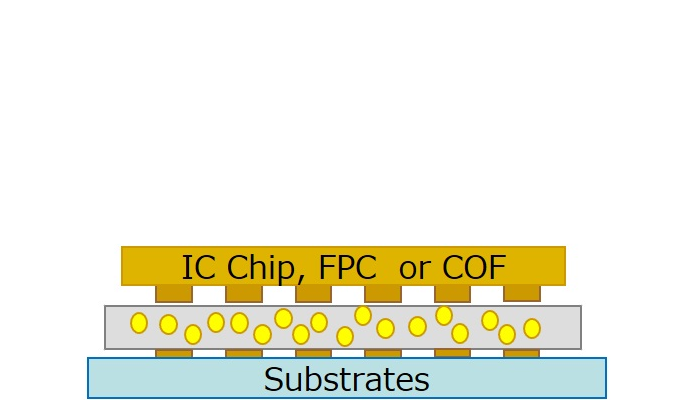
Figure 4.
Thermocompression bonding
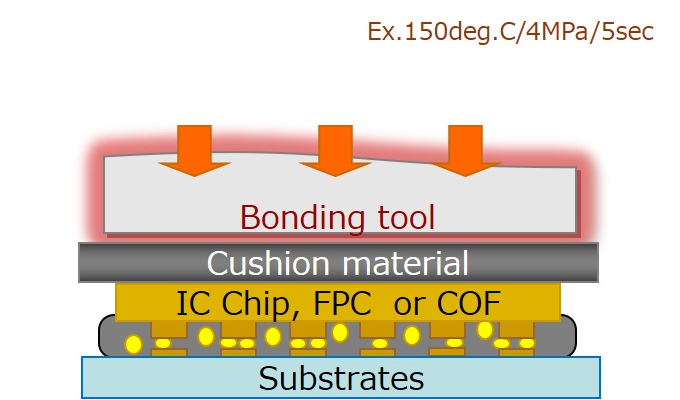
Types of ACF
ACF using thermoset resin
Most ACF products used today are made from thermoset resin. Compared with thermoplastic resin, explained in the following section, thermoset resin excels in electrical resistance of the conductive path, adhesive strength, and insulation quality between adjacent electrodes; moreover, the high reliability of these features is assured. Thermoset resin must be refrigerated, since hardening begins in a warm environment.
RESONAC offers various thermoset resin ACFs in its “ANISOLM” lineup, including ACFs using acrylic resin, cation epoxy resin, and anion epoxy resin, which can satisfy customers’ requirements of thermocompression temperatures or adhesion strength.
ACF using thermoplastic resin
Although not included in RESONAC’s ACF “ANISOLM” series, thermoplastic resin films are also used for various purposes such as circuit connection areas in contactless IC cards (“smart cards”). These types do not require refrigerated storage and can be processed without applying a high temperature thermoset resin, but their uses are limited compared with the more reliable thermoset resin ACF.
ACF using various types of conductive particles
When RESONAC put ACF connection to practical use in small LCD TVs as a world’s first in 1984, as described above, a metal was used as conductive particles. Since then, RESONAC has improved ACF by taking advantage of its particle and resin technologies and dispersion techniques to offer perfect matches with customer requirements and material properties.
For example, we have developed and mass produce nickel-coated spherical resin particles as conductive particles ranging from 3 to 20μm in diameter. Technical emphasis is placed on ensuring that the particles have exactly the same diameter in each grade. We also meet our customers’ requirements regarding the connected area’s thickness, flatness, and connection pitches.
We offer as well conductive particles coated with such noble metals as gold or palladium, which can reduce conductive path resistance and achieve the reliability required by customers.
Please refer to the chart below for resins and conductive particles used in RESONAC’s ACF “ANISOLM.”
We can propose the optimal ACF for your bonding and connection preferences according to the conditions of thermocompression bonding and other processes. Please contact us freely from the “Inquiry” button.
Types of resins and particles used in ACF “ANISOLM”

"ANISOLM" as a solution to ACF delamination
In securing the reliability of ACF connection, strong adhesion is crucial to prevent delamination that disrupts the connection. If the substrate’s surface is contaminated due to inadequate cleaning, the possibility of delamination increases and taking measures to ensure thorough cleaning is essential. Meanwhile, if ACF connection is used to join high-cost materials like the substrates of industrial camera modules, it is important that the film can be removed and reattached when a connection mistake is found.
RESONAC can propose the optimal ACF according to customers’ bonding and connection requirements with various grades of its ACF “ANISOLM.” This section outlines the grades that can solve the delamination issues described above. For specific grade names, please contact us freely from the “Inquiry” button.
Types with strong adhesion
In the ordinary peeling mode in which the part comes off from the edge by external force, the acrylic resin grades with strong adhesion are ideal. RESONAC’s ACF “ANISOLM” comes in a variety of acrylic resin grades, and are particularly known to demonstrate excellence in ACF connection with FPCs such as FOG, FOB, FOF and FOP.
Types with strong contamination resistance
If ACF resistant to surface pollution or contamination is required, the anion epoxy resin grades are recommended. These grades are easy to handle as sufficient adhesion can be achieved even if surface cleaning or measures to prevent contamination are not quite thorough.
Types fit for reworking
Even when using acrylic resin grades with strong adhesion or epoxy resin grades resistant to contamination, it is possible to find the condition to peel off or remove for reworking by choosing the right organic solvent, etc. Please refer to the chart below for an example of the reworking process.
Example of the reworking process
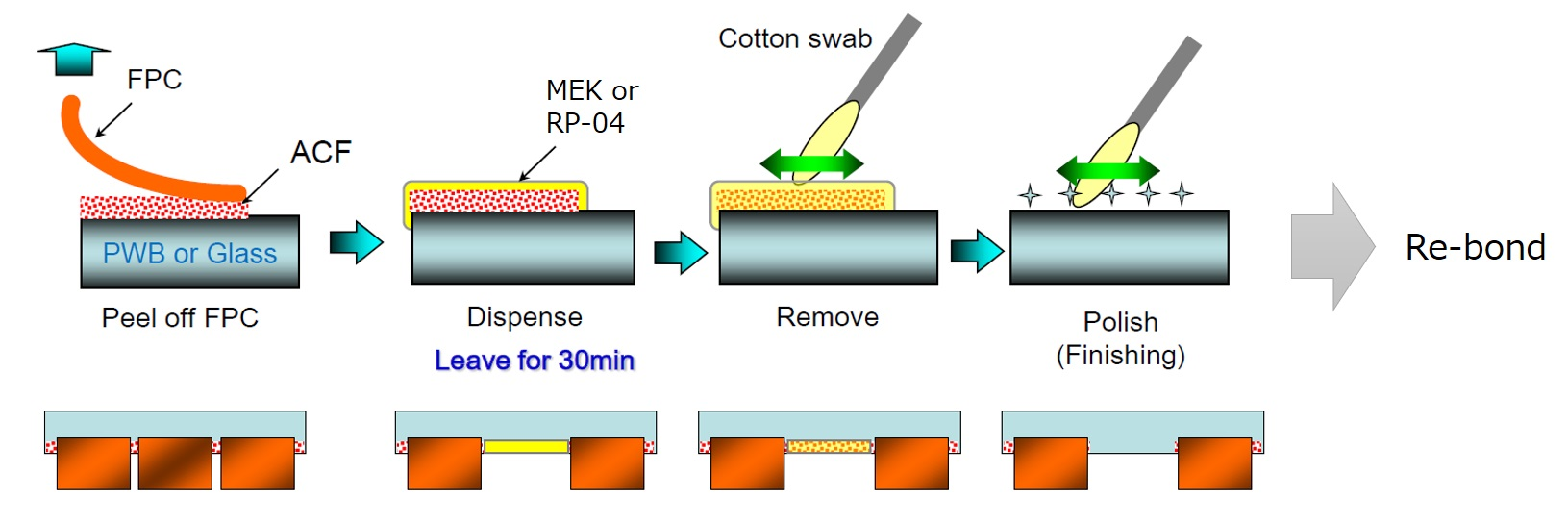
*"ANISOLM" is a registered trademark of Resonac Corporation in Japan, Germany, USA, UK, Benelux, France, Korea, Taiwan, Singapore, Hong Kong, Malaysia, Canada, Italy, and Vietnam.
Author:Hideki Tomozawa
Release date: 7th March, 2023
Need More Information?

Contact Us
Please don't hesitate to contact us if you have any questions.